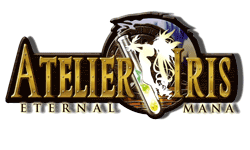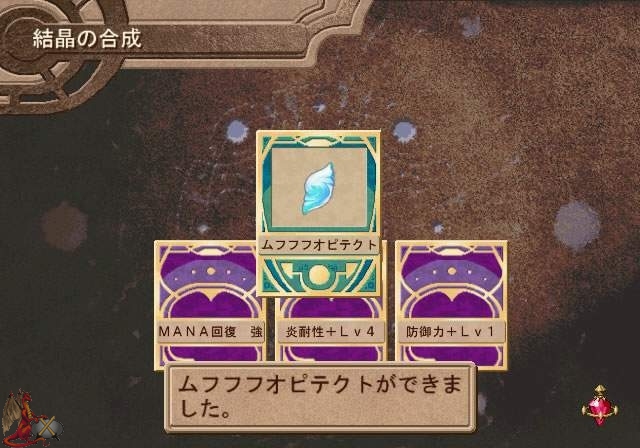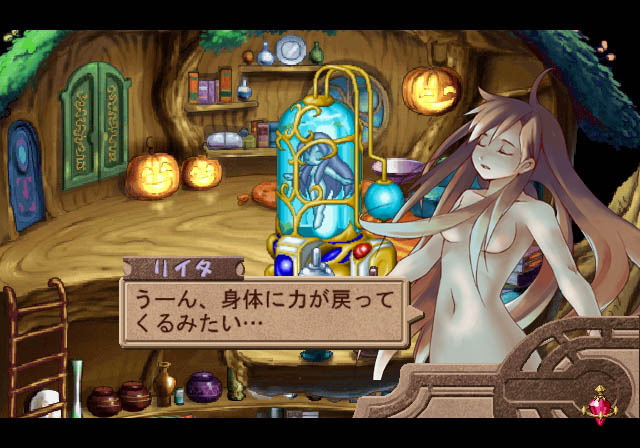|
|

|
PLATFORM
|
PS2
|
BATTLE SYSTEM
|

|
INTERACTION
|

|
ORIGINALITY
|

|
STORY
|

|
MUSIC & SOUND
|

|
VISUALS
|

|
CHALLENGE
|
Moderate
|
COMPLETION TIME
|
20-40 Hours
|
|
OVERALL

|
+ Solid game mechanics with plenty of variety.
+ Great soundtrack.
+ Beautiful graphics.
- A bit laggy.
- Weak story.
- Poor voice acting.
|
Click here for scoring definitions
|
|
|
In the world of Regallzine, a select few individuals, with the help of Mana, can harness the power of alchemy, with Klein, a fledgling alchemist, seeking to master the ancient art. A fateful encounter with a mysterious girl named Lita, however, leads him on a journey to a legendary city in the sky, and to battle an evil threatening the general populace. Gust's Atelier Iris: Eternal Mana, published in North America by Nippon Ichi, was the first of the developer's Atelier series to see release outside Japan, having an emphasis on alchemy and being a worthwhile experience in spite of some technical hiccups and a weak story.
The game's mechanics have major elements in and out of battle, with Klein able to absorb different kinds of elements from objects in towns and dungeons, such as wooden boxes, barrels, and torches, and collect various items lying on the field, some in treasure chests, as well. The player uses elements either to synthesize Mana Items that only Klein can use in battle for offensive or defensive effects, or heal Lita at headquarters during part of the game. The player can also create items at shops (with items having a certain level of quality based on the ingredients used, and shops also having "reputation" based on item quality) that any character can use in battle or equip, with each character able to equip two accessories and one weapon.
Eventually at headquarters, the player can synthesize Mana Crystals from various Mana Stones with help from one of the many Mana Spirits gained throughout the game. Each Mana Crystal provides a certain attribute, such as increased attack or defensive power, and synthesizing Mana Stones with specific Spirits will provide better effects for the created Crystals. The player can fuse Mana Crystals together, with Crystals able to have up to three different attributes each, and some attributes able to combine for greater effects. Finally, players can attach Mana Crystals to certain weapons to enhance their stats, and later remove them to further experiment with them.
Battles in Atelier Iris are randomly-encountered, with the player ultimately gaining the ability to turn off encounters or increase the encounter rate. In combat, the player's three active characters and the enemy take turns depending upon speed, with commands executing instantly after input (unless they require time to charge) like in Final Fantasy X. Characters have the commands of attacking with their weapon (with weapons dealing either physical or magical damage, and sometimes affecting a range of monsters instead of just one), using a normal item, using Mana-consuming special skills (some requiring multiple turns to charge, with the enemy able to cancel them with enough attacks, though the player can do the same against the enemy), defending, switching places with an inactive character, or attempting to escape.
 Not as complicated as it looks
Not as complicated as it looks
|
|
Klein has the added ability to use Mana Items in battle, with some of his Mana-consuming skills able to increase their area of effect or empower them. He can also instantly synthesize Mana Items with elements and use them afterward, not to mention absorb elements from enemies if he lands the killing blow on them. Battles naturally end when the player kills all enemies, and if all the player's characters die, it's Game Over. Interestingly, if a character is dead, that character will still take their turn, with the player able to switch them with a backup character. Whatever character lands the killing blow gains a ten percent experience bonus, with frontline characters gaining the bulk of experience, and backup or deceased characters getting less.
Characters will of course level occasionally, with leveling characters gaining a certain number of points the player can invest into their passive or Mana-consuming skills to level them. The player is eventually able to equip each character with a Mana Spirit, increasing their stats and providing them an additional type of experience after battle, where certain skills, after enough points, will gain bonus points. All in all, the battle mechanics are reasonably solid, with a decent variety and some strategy necessary in a few tough boss fights, and only a few flaws such as the lack of a turn order meter and some occasional long-winded spell animations and lag.
Control in Atelier Iris is solid as well, despite the occasional lag during exploration and menu navigation, and some superfluous menus with regards to Mana Spirits. Klein may also occasionally gain an ability to enhance the player's exploration, such as shooting fire to destroy violet blocks and other obstacles, a barrier to protect from damage areas, and even flight. As a bonus, the player can get a reminder on how to advance the game and even check on current sidequests. An explorable overworld is also present, though the game makes the interesting decision to seal off many parts of it until the player has advanced the plot enough. Overall, interaction helps the game far more than hurts.
Atelier Iris is something of an amalgamation of elements from other RPGs, including its alchemy-centric predecessors, with other series also featuring item creation such as Star Ocean, and the story bearing some resemblance to that in Lunar 2. This iteration does definitely have its creative quirks, such as absorbing elements from various sources and the shop system, which in the end is sufficient to help the game feel fresh in its own right.
 Shades of Lunar 2
Shades of Lunar 2
|
|
Story is Atelier Iris's nadir, with an aforementioned resemblance to Lunar 2: Eternal Blue, bearing elements such as a mysterious girl from an ancient civilization, an ambitious hero with an annoying diminutive mascot, a recurring strong-willed antagonist, and so forth. The plot itself is thinly spread throughout the game, with plenty of non sequitur fetch quests, and a somewhat bland translation that rarely tries, yet fails, to be humorous. Performing synthesis at shops reveals various mini-stories, although these have little influence on the main storyline, and overall, this title is far more about its gameplay than story.
Atelier Iris has a fairly unique soundtrack, with plenty of folksy, bouncy tracks, and energetic battle themes that fit the game, and are mostly pleasant. The English voicework, however, is somewhat weak, though players can change to Japanese voices, which nonetheless sound much the same as other Japanese voices in RPGs. Though the voice acting won't win any awards, the solid soundtrack mostly compensates for it.
Atelier Iris's 2-D art direction is gorgeous, with bright, colorful environs and sprites, along with flashy battle graphics. There is a bit of noticeable lag, and the overworld is a tad foggy, with some other minor incongruities such as Klein's differing hair color at times. While some screenshots, moreover, show shadows for character sprites during exploration, none are oddly present in the game at all outside battle. Despite this, the graphics are a definite visual treat.
Finally, the game is about twenty-five hours long, with a few sidequests and a post-game bonus dungeon potentially lengthening playing time. In the end, Atelier Iris: Eternal Mana is a reasonably solid title with enjoyable mechanics and nice music and graphics. The persistent lag, lackluster plot, and weak English voice acting do somewhat burden the game, but it was still a nice introduction of the series to gamers outside Japan.
Review Archives
|









